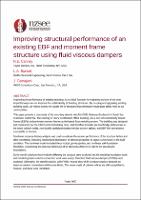| dc.description.abstract | Improving the performance of existing buildings is a critical function for engineers and one of the most impactful ways we can improve the sustainability of buildings. By re-using and upgrading existing building stock, we help to extend the usable life of structures that otherwise would pose safety risks to our communities.
This paper presents a case study of the voluntary seismic retrofit of 651 Gateway Boulevard in South San Francisco, California. The existing 17-story steel framed office building uses a core of eccentrically braced frames (EBFs) and perimeter moment frames as the lateral force resisting system. The building was designed and constructed per the 1982 Uniform Building Code, and therefore includes pre-Northridge deficiencies in the beam-column welds, non-ductile partial penetration welded column splices, and EBF link connections susceptible to fracture.
Nonlinear response-history analysis was used to evaluate the seismic performance of the structure before and after retrofitting, including randomized distribution of element properties to capture uncertainty in the built condition. The nonlinear model included the principal gravity girders, and nonlinear soil-foundation flexibility, considering the potential behavior of all elements of the force path to the precast pile foundations.
Early retrofit solutions that involved stiffening the structure were explored, but the resulting foundation work and remaining beam-column connection work were costly, therefore fluid viscous dampers were explored. Ultimately, the retrofit solution with FVDs reduced story drift to reduce rotation demands on beam-to-column connections within code limits. The lower levels of column splices are still susceptible to fracture, and these were retrofitted. | |

